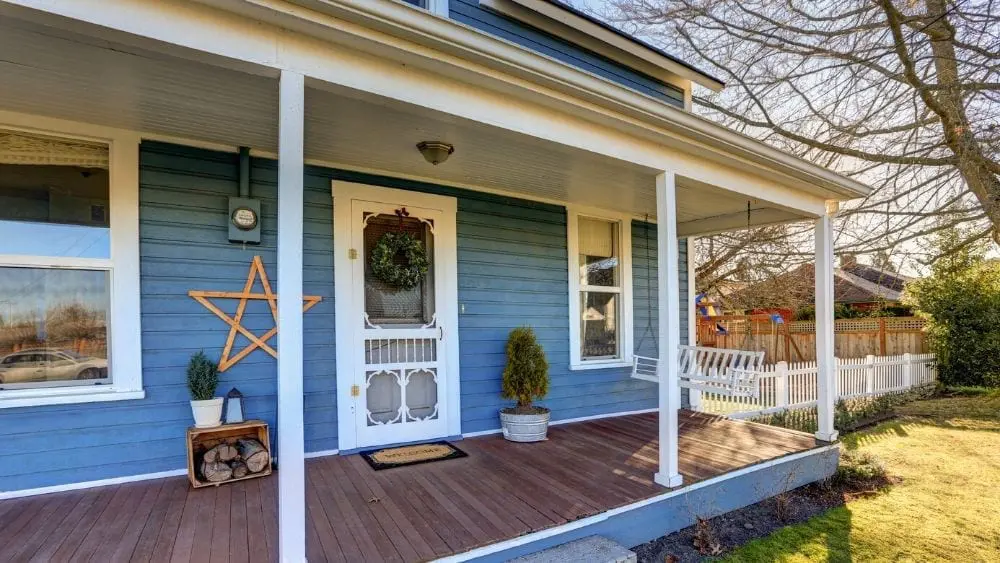
Vinyl siding, stone, stucco, brick, wood, and fiber-cement are among your choices to cover the exterior of your home. Animal hides and grass sod blocks were probably the first home siding materials. The selection was limited, the options simple.
Today, your choices for the exterior siding of your new home have broadened considerably.
Take your pick: there’s vinyl siding, polypropylene siding, polymer shakes and shingle siding, pultruded-fiberglass siding, fiber cement siding, aluminum siding, steel siding, panelized stone veneer siding, red cedar and hardwood siding, modified wood siding, plywood siding and engineered wood siding products, such as oriented strand board (OSB) and laminated veneer lumber (LVL).
If you discount the universal love of brick, the most common siding material today easily is vinyl. Statistics from the National Association of Home Builders (NAHB) bear this out. In the NAHB’s latest “What Home Buyers Really Want” survey, released in January, 21 percent of potential home buyers said they’d select vinyl siding. But other materials are not that far behind. Stone comes in at 16 percent, stucco at 12 percent, wood at 7 percent, fiber cement at 5 percent and aluminum siding at 4 percent. And a few, especially fiber cement siding, are growing fast.
When shopping for siding, Mike Kemper, director of marketing/siding for Associated Materials Inc., advises checking manufacturer websites. Most include online visualization tools to help in your selection.
Going for the Look of Wood
For siding designers, natural wood is the Holy Grail. “With engineered wood, vinyl and fiber cement siding,” says Jason Rowell, segment marketing manager for LP Building Products, “we’re all trying to replicate the look of real wood.”
LP achieves this with its popular SmartSide oriented strand board (OSB) lap and board-and-batten siding material. Alside Satinwood steel siding duplicates the natural look of wood in clapboard, Dutch lap and board-and-batten profiles. Envoy aluminum siding from Mastic Home Exteriors by Ply Gem achieves the look of wood with a realistic shadow line where the panels appear to overlap.
Virtually any wood pattern can also be duplicated in vinyl or fiber cement. Both are offered in wood-like clapboard panels and half-round cedar-style shingles and various profiles. JamesHardie’s new Artisan premier lap siding is a thicker, high-end product that offers the look of cedar with deep shadow lines.
Real wood siding products work, too. Georgia-Pacific’s Plytanium plywood exterior siding is an exterior-grade panel with edge-coating and a primer/sealer for added weather protection. More upscale is western red cedar siding. Cedar siding is available in several textures, sizes and styles. Beveled siding is the most popular. Currently, higher quality cedar sidings are taking share from the lesser grades of cedar, according to Reed Brunson, business development manager, Weyerhaeuser Distribution. Dried or seasoned siding and trim, versus green or unseasoned, is the “asked for” option, he says.
A radically new siding product made from Accoya wood is being marketed by Universal Forest Products. Accoya is a chemically modified wood technology based on wood acetylation. Non-toxic chemicals treat fibers all the way to the core. As a result, the material has high UV resistance, dimensional stability and carries a 50-year above-ground guarantee.
A World of Color
Unlike Henry Ford’sModel T, siding can be had in almost unlimited colors. The Vinyl Siding Institute (VSI) has certified more than 350 different colors, according to VSI president and CEO Jery Y. Huntley. Traditionally, bright colors have been featured in coastal areas, greens in the Northwest and earth tones in the Southwest. “In recent years,” Huntley says, “with advanced color formulations, manufacturers have introduced new, darker color options such as bold rich earth tones, including barn reds, hunter and sage greens and deep blues.” Medium dark colors are also now available in thinner gauge sidings.
Jerry Blais, vice president, marketing, Ply Gem siding group, agrees. “Darker and earth-tone siding hues are becoming more popular,” he says, “and really make the curb appeal ‘pop.’ Mastic’s Color Advisor iPad app and the Designed Exterior Studio on plygem.com, showcase the options and allow homeowners to get a head start on color selection.”
Engineered wood and fiber cement siding manufacturers have joined the fun, offering a wide pallet and a variety of pre-colored or prefinished options. Usually you see more neutral tones such as beige and browns, but manufacturers can provide almost any color desired. For the ColorPlus Technology program from JamesHardie, color pro Leslie Harrington has handpicked custom color combinations to help consumers select siding colors that work best with the style of their home.
CertainTeed just introduced 16 new colors across its WeatherBoards fiber cement, polymer and vinyl siding lines. The firm offers ColorCoach, a Swatchbook-like web applications.
Mixing and Matching
Today, it’s okay to mix and match. Matching involves coordinated the style and color of your siding selection with other exterior products, such as doors, windows, decking and even roofing. Trim pieces, urethane millwork details, and siding accessories might be colored to contrast with the siding.
But it’s also common to see mixing of styles and materials. You see lap siding on the exterior with polymer shakes or corbels on the gable ends, board-and-batten siding in the peaks or stone veneer as an accent. “LP provides a cedar shake look,” says Rowell, “which you often see on gables. Our trim boards can be used with our panel siding to create a board and batten effect. There also are options on the thickness and depth of the trim so you can achieve different looks.” LP also offers a stucco-like finish on its SmartSide product.
Polymer siding, made from polypropylene resin, is commonly used as a cedar-patterned, shake-and-shingle style covering for accent areas. Produced by an injection molding process, the siding offers a three-dimensional pattern and is available in a variety of sizes, colors and styles. CertainTeed offers six types of polymer siding under the name, “Cedar Impressions.”
Stone veneer cladding products are a cost-effective way to add exterior accents by duplicating the look of natural stone. Boral suggests choosing a style and stone that is native to your area so that the finished design looks at home in its setting.
Emphasis on Sustainability
With today’s sustainable and energy-conscious environment, it’s not surprising that there is an increased emphasis on maximizing the energy efficiency of siding products. “Insulated vinyl siding is now an important part of the conversation,” says VSI’s Huntley. “It helps to increase the R-value (insulation measurement) of a home’s exterior walls.”
The Vinyl Siding Institute is launching a certification program for insulated siding and will announce the first certified insulated siding products this summer. To qualify, a siding must have a minimum R-2 rating. Insulated siding is also more rigid and allows wider profiles, such as double six-inch and single seven-inch styles.
CedarBoards insulated vinyl siding from CertainTeed was the first product to achieve the new GreenCircle Certified, LLC, third-party certification earlier this year. The labeling program details a product’s environmental information, sustainable attributes and key manufacturing impact reductions.
Foam insulation systems for backing fiber cement siding have also been developed and are now on the market. These formed-foam backer boards are designed to mold to the back of the siding, filling gaps and even providing for guided, quicker siding installation.
Durable and Lasting
Siding manufacturers have also been active in improving product life-cycle longevity. To increase product durability, especially in areas with winter climates, JamesHardie has established two Hardie Zones (HZ) and modified products for each zone. HZ5 products are specially formulated for northern climates where freeze-thaw conditions are an issue. HZ10 is for southern climates. The characteristics of fiber cement siding can be altered by adding air-entrainment and/or decreasing the water-cement ratio of the concrete mix.
Pultruded fiberglass is a relatively new siding material that can withstand extreme temperatures. Pultrusion consists of pulling fiberglass strands through a resin and heated die. Lap siding made with the material can withstand temperature extremes. APEX manufactures a pultruded fiberglass siding made with Ultrex, an innovative product pioneered by Marvin that incorporates an integrated acrylic finish.

Roy Diez is a freelance writer and marketing professional specializing in the architectural, building and construction industry. He is a former editor-in-chief of Professional Builder magazine.
 Crystal Lagoons: The Next Great Amenity?
Crystal Lagoons: The Next Great Amenity?